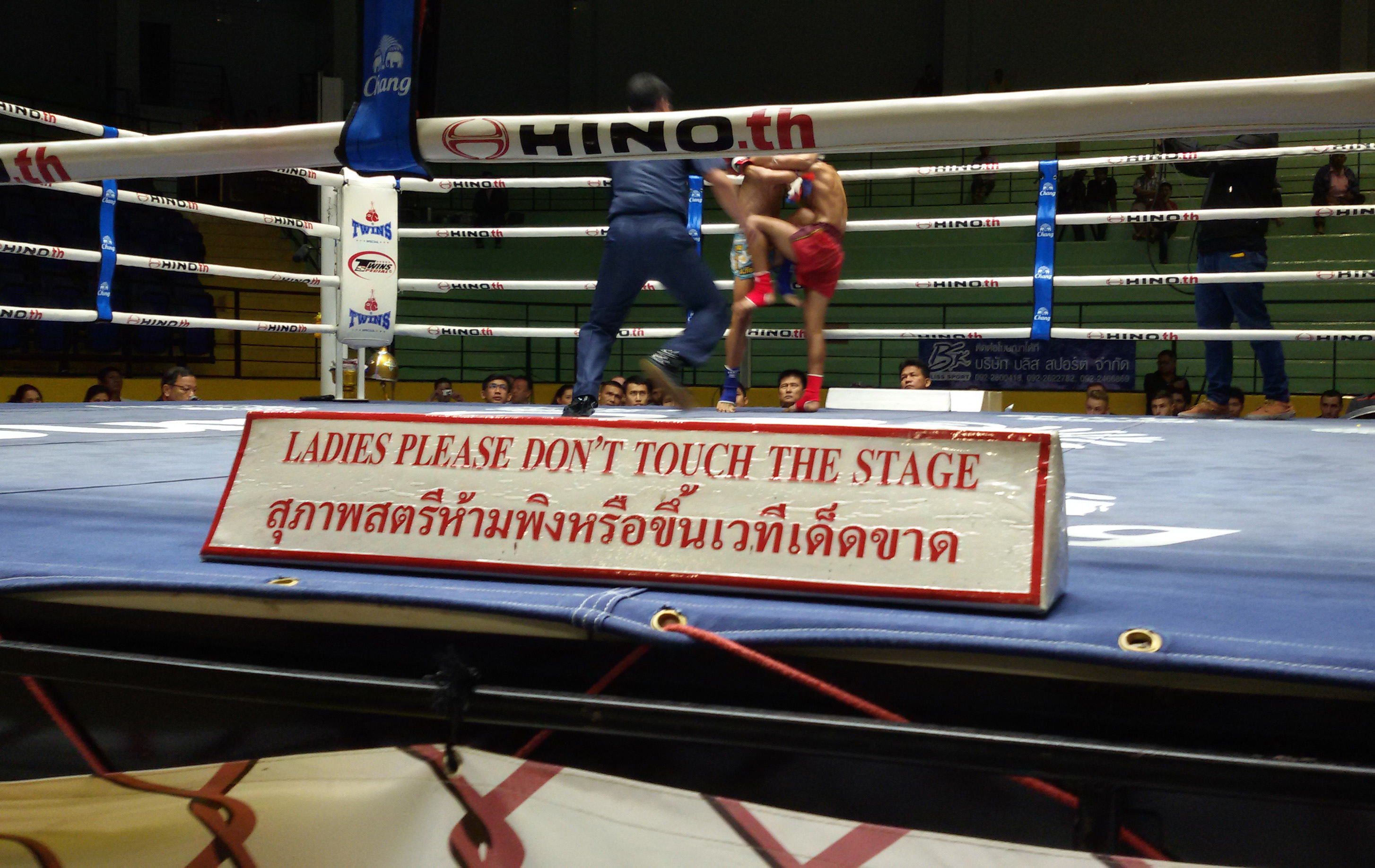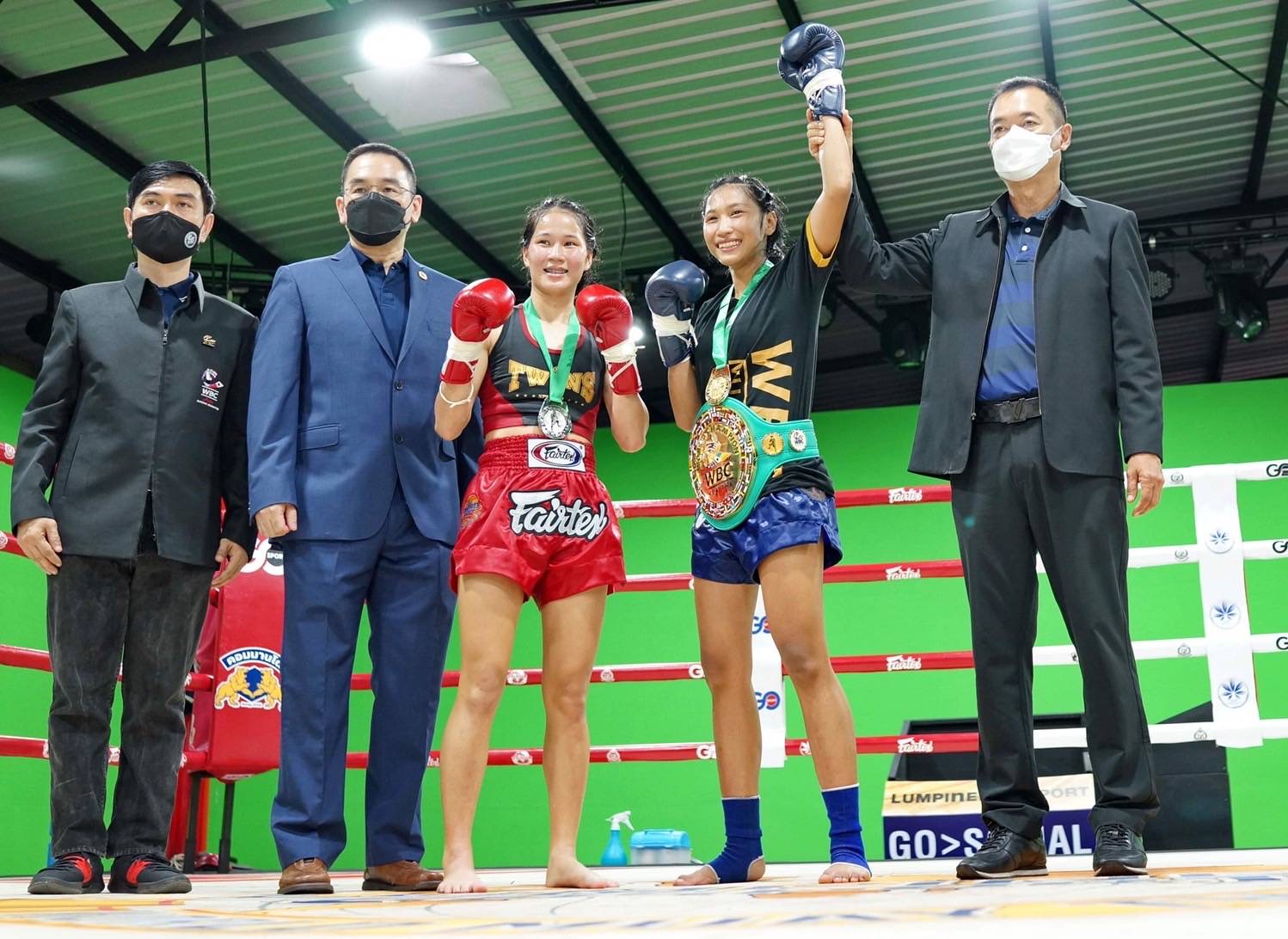Since opening in 1956, Lumpinee Boxing Stadium has become one of the world’s most prestigious sites for Thailand’s martial art of Muay Thai. But the venue in Bangkok has traditionally forbidden women from fighting there—or even touching the ring—due to entrenched superstitions about menstruation and its potential to “pollute” the sacred space.
Signs placed around the ring are clear: “Ladies please don’t touch the stage.”
Videos by VICE
But change arrived on Saturday evening in a bout between two Muay Thai fighters said to be the first women to vie for a championship title at Lumpinee, ending a decades-long practice and paving the way for aspiring female boxers.
The fight generated enormous interest in Thai boxing circles, with anticipation that built after it was postponed several times because of the pandemic. But virus control measures meant the media were barred from covering it in person, and live audiences were not allowed.
A temporary open-air stadium was also constructed on the grounds of Lumpinee for the event, since the government does not allow any indoor or air-conditioned matches. Even the size of the crew was limited.

So viewers watched highschooler Nirawan Tangjew triumph over 20-year-old Tanawan Thongduang on screen. Nirawan dominated the early action, pushing forward unopposed during the first two out of five rounds. Tanawan’s attempts to strike back were thwarted as Nirawan resorted to “teeps” or front kicks to control the distance between them. In the last round, Nirawan dropped Tanawan to the mat with a powerful left kick. Judges gave the win to Nirawan, earning her the World Boxing Council (WBC) mini flyweight belt in Muay Thai.
“I’m overjoyed,” Nirawan, 17, told VICE World News after the match. “It’s like, wow, I actually did it,” she said.
Despite not having won the title, Tanawan said she was still honored to have fought in the venue.
“I’m a little sad not having won, but I’m so happy and proud to have been given the opportunity to be in the historical first female match in Lumpinee,” the university student told VICE World News on Sunday. “It’s something I’ve never dreamed could happen to me. You know, when you go watch the matches there, they won’t even let females come near the stage. So to be able to be in that ring is such a huge honor for me.”

Both women started training at a young age.
Nirawan, who fights under the name “Sanaejan,” was born into a boxing family. She has been training at her father’s gym since she was 12. She is the second of three children, all of whom are professional boxers. The family also lives at the gym. Before opening his own training facility, her father, Chamni Tangjew, helped manage and train boxers in their hometown in the east of Thailand. He taught his daughter out of sheer pragmatism.
“I originally wanted my daughter to box in order to stand up for herself against bullies,” the 55-year-old said Thursday morning, after his daughter finished the weigh-in. “But she ended up actually really liking it, and she also had lots of potential as well as dedication. So we decided to enter her in an amateur fight.”
“I originally wanted my daughter to box in order to stand up for herself against bullies.”
Though she had just started boxing, young Nirawan ended up winning that first match. She’s been training seriously ever since.
Every morning, the highschooler wakes up around 5:30 a.m. and goes on a run for about an hour. She then trains before going to school at 8 a.m. After school, she starts running again for half an hour, and trains some more until about 8 p.m. Except for days off to rest or relax, this has been her routine every day since she started fighting five years ago, according to her father.
“We always have to keep her body fit and ready,” Chamni said.
The family’s dream for the near future is for Nirawan to compete in the Olympics, which recently certified Muay Thai as a future Olympic sport. Chamni doesn’t believe this is far-fetched, given his daughter’s passion and dedication. Thailand also has a solid track record in combat sports, earning one gold medal for Taekwondo and one bronze medal for boxing in the Tokyo Games.
While mindsets are changing fast, the backlash Chamni got when he started training his daughter shows how some in the Muay Thai world are uncomfortable with a more inclusive version of the sport.
“Some people would ask me, ‘Why would you let your daughter fight? She’s going to get hurt.’ They were among the minority, though,” he said. “There are no differences between men and women. Women can be anything—even a prime minister, a musician or any other career that a man can pursue.”
His daughter, Nirawan, who has grown up seeing more and more women enter the Muay Thai industry, agrees.
“Keep fighting and stay dedicated,” she advises other aspiring female boxers. “Stadiums are starting to be more accepting towards female boxers. Women will have many more opportunities in this industry. So, stay motivated.”

Tanawan, who goes by the name Buakaw as a fighter, started Muay Thai when she was around 7 years old. From southern Thailand, she started competing within the first year of her training. She currently lives in a Muay Thai camp.
Now that school has been moved online, the third-year university student can devote the majority of her day to the sport. She starts at 6 a.m., and it lasts about three hours. In the afternoon, she also trains from 4 p.m. to around 7 p.m.
The long hours are not a problem for Tanawan, who sees the sport as a gift. “Muay Thai gave me a new life,” she said. “It taught me discipline, hard work and responsibility. It was also a way for me to earn a living, which is how we have better livelihoods.”
Known as the “art of eight limbs,” Muay Thai is characterized by the use of fists, elbows, knees and shins. The history of the sport can be traced back to at least the 16th century when it was practiced by soldiers in the Ayutthaya Kingdom. Though it has long been popular in Thailand, Muay Thai has gone global in recent decades with the rise of mixed martial arts as a mainstream sport.
But women and Muay Thai have had a complicated relationship in Thailand. Even in many gyms across the country today, women have to crawl under the bottom of the last rope in order to enter the ring. Men, on the other hand, have the top rope pulled down and hop over it. Despite the historic nature of Saturday’s fight, this tradition remained in place.
“In the past, some people believed menstruation as something dirty and that bled into the Muay Thai industry. Over time, that belief became a custom and tradition,” said Suwanna Srisongkram, who is credited with being Thailand’s first woman sports commentator and is the longtime editor-in-chief of Muay Champ magazine.
“I was always skeptical of this when I was young. I was a very stubborn child. If I don’t see things myself, I don’t believe it,” she told VICE World News. “But when everyone around you, including all the adults and your parents, are saying the same thing, you can’t just go against it. I’m only one person. Imagine me showing up and saying that in a boxing stadium full of men. Who would actually listen to me?”
Suwanna recalls a story—which has become more of a legend than a verifiable event—where a nurse entered the ring to treat a boxer’s wound on the first match of an evening. The rest of the fights all ended in bloody technical knockouts, or so the story goes.
Acceptance has grown, however. While prohibitions still exist in different forms from place to place, rules on how women can enter the ring or whether they can fight in it have disappeared in many places. Lumpinee Boxing Stadium, however, has held true to tradition until now.
“Since I was little, I have heard that Lumpinee stage is historical and sacred, so women are not allowed on it,” said 23-year-old Stamp Fairtex or Natthawan Panthong, the Thai atomweight kickboxing world champion signed to ONE Championship. “I’ve always wanted to be the first one to get on that stage.”
Natthawan remembers the lack of respect accorded to women’s competitions when she got into the sport.
“When I first started boxing, people associated women boxing with silly slap fights. They didn’t think our punches and kicks were strong, and [for them] it wasn’t as fun to watch as male boxing,” she said.
“When I first started boxing, people associated women boxing with silly slap fights.”

Run by the Royal Thai Army, Lumpinee stadium first opened its doors in December of 1956. It was Thailand’s second “standardized gym,” about a decade behind Rajadamnern Stadium, the country’s other famous Muay Thai venue. Before these places opened, everything was much less regulated, according to the president of the Thai Boxing Creative Media Club, Prasert Horthamrat.
“Back then, boxing matches were mostly held outside of Bangkok. They were amateur matches where there weren’t really clear rules,” he told VICE World News. “Gambling was also a custom that has long been with Muay Thai. People would bet on boxers from different communities.”
Over the years, Rajadamnern and Lumpinee stadiums have become two of the most important Thai boxing arenas in the world. For Muay Thai boxers nowadays, little beats the prestige of holding the title of “Muay Thai Champion of Lumpinee.”
The groundbreaking women’s match followed years of efforts for greater inclusivity at Muay Thai venues, aided by pioneering transgender boxers who have fought against men at both Lumpinee and Rajadamnern stadiums.

“Since Lumpinee’s opening 65 years ago, there has never even been a single female match in the stadium. Not a single one. Women are not even allowed on the stage. That has always been the rule, the custom,” promoter Sitthirut Sateanjarupongsa said. “I’m the first promoter to have the opportunity to put together a female fight there.”
Sitthirut said he wanted to level the playing field by letting female boxers fight in nationally recognized stages like Lumpinee—earning him heavy criticism and backlash from traditionalists in the industry.
“Most of the people who are pushing back are mostly who I would call old-fashioned. The only reasons they give are customs and traditions. What does that even mean anymore?” he asked. “Female boxers are accepted all over the world.”
“Nowadays, males and females are equal—in terms of combat sports in Thailand as well,” Sitthirut added. “Muay Thai wasn’t made just for men.”
Follow Teirra Kamolvattanavith on Twitter.






